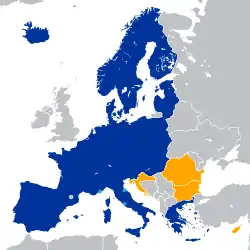Entry-Exit-System
The Entry-Exit-System EES - or Entry/Exit System (EES) - is a large-scale IT system planned by the European Union for the automatic monitoring of the border-crossing of third-country nationals (non-EU/EEA/Swiss citizens). Envisioned to replace passport stamps, the system will be installed at the external border crossing points of the Schengen Area, e.g. airports and seaports. As of April 2020, EES is scheduled to enter into operation sometime in the first quarter of 2022.[1][2][3] EES will be based on the EU-Regulation 2017/2226.[4]
 Map of Europe Schengen Area Countries with open borders but not part of the Schengen or the EU Members of the EU legally obliged to join the Schengen area, but not yet members | |
| Policy of | |
|---|---|
| Type | Open borders area |
| Established | 1995 |
| Members | |
| Area | 4,312,099 km2 (1,664,911 sq mi) |
| Population | 419,392,429 |
Function
The task of EES is to collect data of border-crossing of third-country nationals at the external border of the EU and to abolish passport stamps. Collected data will include the name and date of birth of the traveller, as well as dates of entry and exit into/from the Schengen Area. Beside these alphanumeric data points, it is planned to store biometric data like pictures and fingerprints.
Operation
EES will be operated by the EU's IT agency eu-LISA. The system launch was originally scheduled for 2020. However, according to the Swiss Federal Customs Administration, the launch has reportedly been delayed to sometime in the third quarter of 2021.[5][6] As of April 2020, the planned date for the entry into operation of EES is the first quarter of 2022 due to the coronavirus pandemic.[1]
European Union Regulations
- Regulation (EU) 2017/2226 of the European Parliament and of the Council of 30 November 2017 establishing an Entry/Exit System (EES) to register entry and exit data and refusal of entry data of third-country nationals crossing the external borders of the Member States and determining the conditions for access to the EES for law enforcement purposes, and amending the Convention implementing the Schengen Agreement and Regulations (EC) No 767/2008 and (EU) No 1077/2011 (OJ L 327, 9 December 2017, p. 20)
- Regulation (EU) 2017/2225 of the European Parliament and of the Council of 30 November 2017 amending Regulation (EU) 2016/399 as regards the use of the Entry/Exit System (OJ L 327, 9 December 2017, p. 1)
References
- "Smart Borders". European Commission. Retrieved 29 March 2020.
- https://edri.org/smart-borders-the-challenges-remain-a-year-after-its-adoption/
- Staff. "Entry-Exit-System/European Travel and Authorization System (EES/ETIAS)". Switzerland Federal Customs Administration. Retrieved 20 February 2020.
- "L_2017327EN.01002001.xml". eur-lex.europa.eu.
- Staff. "Entry-Exit-System/European Travel and Authorization System (EES/ETIAS)". Switzerland Federal Customs Administration. Retrieved 20 February 2020.
- EU Smart Borders European Agency for the Operational Management of large-scale IT Systems in the Area of Freedom, Security and Justice
